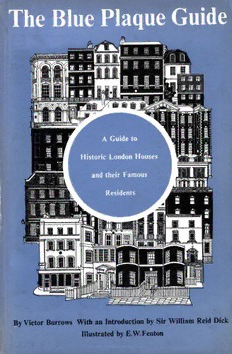
The Blue Plaque Guide ... to Historic London Houses and their Famous Residents PDF
Preview The Blue Plaque Guide ... to Historic London Houses and their Famous Residents
The Blue Plaque Guide DanteGabriel Rossetti, 16CheyneWalkS.W.) The Blue Plaque Guide to historic London houses and the lives of their famous residents Edited by Victor Burrows with an introduction by Sir William Reid Dick and drawings by E. W. Fenton Newman Neame London 1953 First publishedin March 1953 by Newman Neame Limited 50 Fitzroy Street, London, W.l. AIIrights reserved Printedin Great Britain by Hunt, Barnard and Company Limited Prefatory Note The names in this guide are arranged alphabetically and are numbered serially. If the reader wishes to visit houses in a particular district he may do so by referring to the map, whose numbers correspond to the numbers against the text entries. A bracketed date at the end of an entry refers to the year in which a commemorative plaque was erected. Acknowledgments The editor and the publishers wish to express their gratitude to the Clerk, the Librarian and other officers of the London County Council who have made freely available the records and facts collected by the Council in the course of identifying housesand assessingtheclaimsofpersons tobecommemorated. Introduction Iwas particularly pleased to be invited to introduce The Blue Plaque Guide because I feel that to commemorate those who have given something lasting to the culture ofa city or a country is an act of some importance to us all. Statues erected to great men generaIIy require no introduction because they, and other large monuments, mark achievements that have become part ofour history. They are outstanding, both in the events they call to mind and in the places they occupy in our cities. They commemoratethe extraordinary momentsin the livesofextra ordinarymen and women. But this book draws ourattention to the general scene. Ittakes us through the streets of London to the houses marked by the distinc tivememorial plaques of the London CountyCounciland the Royal Society of Arts. On each ofthese one will find a briefnotice to the effect that such and such a person 'lived here'. Notices ofthis kind do notnecessarily remind us of the outstandingmomentsofpeople's lives; they remind us, rather, of the domestic affairs of their daily existence. A memorial plaque may strike one as a very modest way to com memorate thelifeofa man, but in their full rangethese plaquesbuild up a many-sided picture of the city's achievement, bringing home to one a more complete idea ofthe activities ofdifferent ages. We are reminded of the cosmopolitan character of London when we read thatit wasin Ebury Streetthat, at the age ofeight, Mozartwrotehis first symphony; in Gower Street that Mazzini spent his exile; from King Street that Napoleon III joined the special constabulary; in Hereford Road that Marconi conducted his experiments in wireless telegraphy. One realises, also, that Earnshaw, the chronometer maker, and Turner, the engraver, were as great in their particular waysas the statesmen, generals and artists with whom we are more familiar. But perhaps the most absorbing thing about this Guide isthe way inwhichitbrings usinto directcontactwith the livesof these people. 7 Wehaveapicture ofSirHenry Jrvingin hisrooms inGrafton Street with 'yawning gapsinthe bookshelves, from whichthe volumesnow strewing the floor have been hastily dropped forreferenceor study. . . .At the foot of the music stool is a large brown-paper package obviously containing boxes of cigars ... and the broad sofa seems, from the variety of its contents, to have lost its identity, and to be undecided whether it wasintended for a wardrobe, a bookcase or a portfolio... .' Heine,in Craven Street,reminds usthatnot everyone found London to be the city ofhis dreams: 'it is so fearfully damp and uncomfortable here, and no one understands me'. This makesa rich contrast to the full and varied lifelivedby Edmund Kean and his wifein Clarges Street. 'Mrs Kean, who loved a fashionable life, formed thecentre ofa titled and distinguished crowd, givingdinners and planning socialtriumphs. But Kean waslikelyto befound box inginthedining-roomwiththe pugilistsMendoza and Richmond or fondling his tame American lion in the drawing-room.' I particularlyliked the glimpseofWilliam Morris whoserooms in Red Lion Square weregradually provided with 'intensely mediaeval furniture ... as firm and as heavyas a rock', and of Gainsborough inPallMallwhowas'a quick-temperedman, occasionallyfallingout with his wife as well as the president of the Royal Academy, Sir Joshua Reynolds. These quarrels between the two men,weare glad to hear, 'were quicklyended byan exchangeof notessignedwiththe names of their pet dogs'. Allthefamous Londonersare here. BosweIl and JohnsoninGreat Portland Street and Gough Square, Dickens in Holborn, and, in Hampstead, John Keats, the most famous of the 'cockney school of poets', recovering from the vicious attacks on his poem Endymion and writing the famous letters to Fanny Brawne whom he had met in the house next door. One is reluctant to leave so livelyand interesting a collection of facts and anecdotes. The book is the perfect complement to the London County Council scheme, and when one has finishedit one feels that one has been drawn into the city and made aware of it more intimately and directly than before. The illustrations are not onlydecorative; theyadd considerably to the value ofthe book. One may seeat a glance the varied stylesof architecture to be found in London. For example, the beautiful Regency facade of the Adelphi Terrace, the Adam doorway of 65 8
